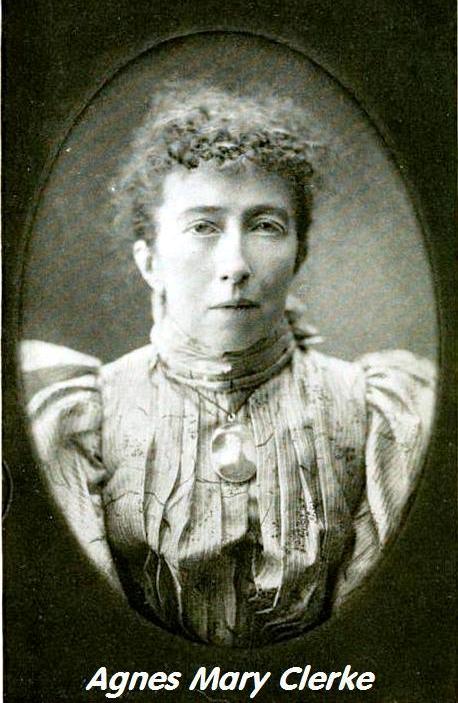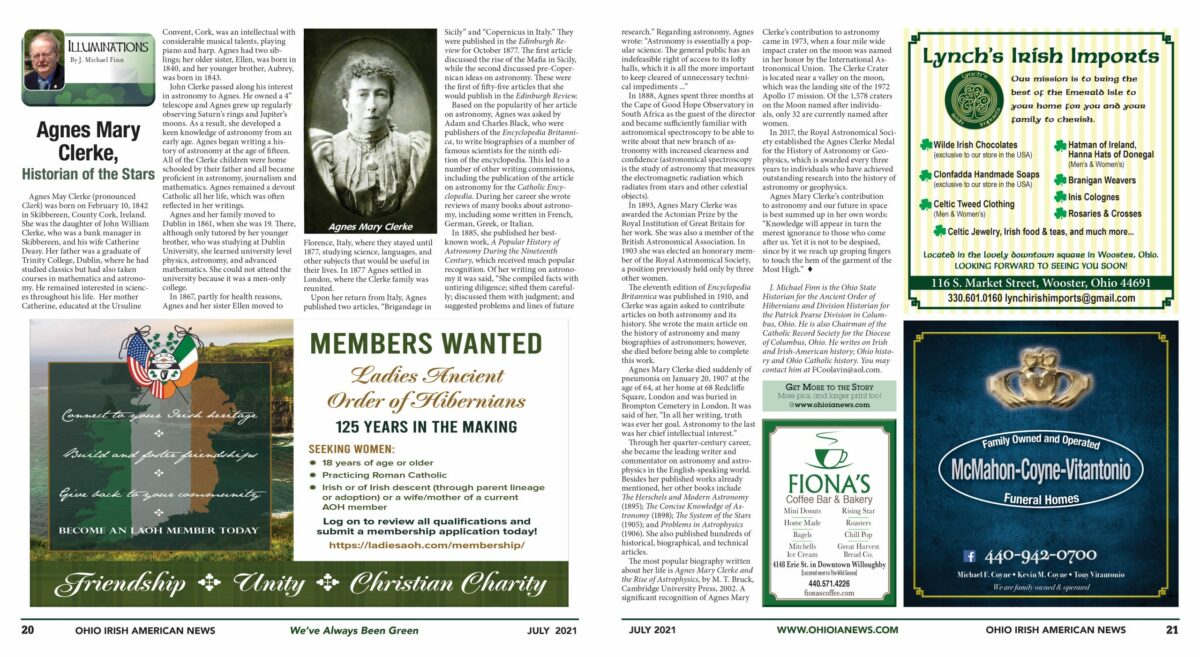

Illuminations: Agnes Mary Clerke, Historian of the Stars
By: J. Michael Finn
Agnes May Clerke (pronounced Clark) was born on February 10, 1842 in Skibbereen, County Cork, Ireland. She was the daughter of John William Clerke, who was a bank manager in Skibbereen, and his wife Catherine Deasy. Her father was a graduate of Trinity College, Dublin, where he had studied classics but had also taken courses in mathematics and astronomy. He remained interested in sciences throughout his life.
Her mother Catherine, educated at the Ursuline Convent, Cork, was an intellectual with considerable musical talents, playing piano and harp. Agnes had two siblings; her older sister, Ellen, was born in 1840, and her younger brother, Aubrey, was born in 1843.
John Clerke passed along his interest in astronomy to Agnes. He owned a 4” telescope and Agnes grew up regularly observing Saturn’s rings and Jupiter’s moons. As a result, she developed a keen knowledge of astronomy from an early age.
Agnes began writing a history of astronomy at the age of fifteen. All of the Clerke children were home schooled by their father and all became proficient in astronomy, journalism and mathematics. Agnes remained a devout Catholic all her life, which was often reflected in her writings.
Agnes and her family moved to Dublin in 1861, when she was 19. There, although only tutored by her younger brother, who was studying at Dublin University, she learned university level physics, astronomy, and advanced mathematics. She could not attend the university because it was a men-only college.
In 1867, partly for health reasons, Agnes and her sister Ellen moved to Florence, Italy, where they stayed until 1877, studying science, languages, and other subjects that would be useful in their lives. In 1877 Agnes settled in London, where the Clerke family was reunited.
Upon her return from Italy, Agnes published two articles, “Brigandage in Sicily” and “Copernicus in Italy.” They were published in the Edinburgh Review for October 1877. The first article discussed the rise of the Mafia in Sicily, while the second discussed pre-Copernican ideas on astronomy. These were the first of fifty-five articles that she would publish in the Edinburgh Review.
Based on the popularity of her article on astronomy, Agnes was asked by Adam and Charles Black, who were publishers of the Encyclopedia Britannica, to write biographies of a number of famous scientists for the ninth edition of the encyclopedia. This led to a number of other writing commissions, including the publication of the article on astronomy for the Catholic Encyclopedia. During her career she wrote reviews of many books about astronomy, including some written in French, German, Greek, or Italian.
In 1885, she published her best-known work, A Popular History of Astronomy During the Nineteenth Century, which received much popular recognition. Of her writing on astronomy it was said, “She compiled facts with untiring diligence; sifted them carefully; discussed them with judgment; and suggested problems and lines of future research.”
Regarding astronomy, Agnes wrote: “Astronomy is essentially a popular science. The general public has an indefeasible right of access to its lofty halls, which it is all the more important to keep cleared of unnecessary technical impediments …”
In 1888, Agnes spent three months at the Cape of Good Hope Observatory in South Africa as the guest of the director and became sufficiently familiar with astronomical spectroscopy to be able to write about that new branch of astronomy with increased clearness and confidence (astronomical spectroscopy is the study of astronomy that measures the electromagnetic radiation which radiates from stars and other celestial objects).
In 1893, Agnes Mary Clerke was awarded the Actonian Prize by the Royal Institution of Great Britain for her work. She was also a member of the British Astronomical Association. In 1903 she was elected an honorary member of the Royal Astronomical Society, a position previously held only by three other women.
The eleventh edition of Encyclopedia Britannica was published in 1910, and Clerke was again asked to contribute articles on both astronomy and its history. She wrote the main article on the history of astronomy and many biographies of astronomers; however, she died before being able to complete this work.
Agnes Mary Clerke died suddenly of pneumonia on January 20, 1907 at the age of 64, at her home at 68 Redcliffe Square, London and was buried in Brompton Cemetery in London. It was said of her, “In all her writing, truth was ever her goal. Astronomy to the last was her chief intellectual interest.”
Through her quarter-century career, she became the leading writer and commentator on astronomy and astrophysics in the English-speaking world. Besides her published works already mentioned, her other books include The Herschels and Modern Astronomy (1895); The Concise Knowledge of Astronomy (1898); The System of the Stars (1905); and Problems in Astrophysics (1906). She also published hundreds of historical, biographical, and technical articles.
The most popular biography written about her life is Agnes Mary Clerke and the Rise of Astrophysics, by M. T. Bruck, Cambridge University Press, 2002. A significant recognition of Agnes Mary Clerke’s contribution to astronomy came in 1973, when a four mile wide impact crater on the moon was named in her honor by the International Astronomical Union.
The Clerke Crater is located near a valley on the moon, which was the landing site of the 1972 Apollo 17 mission. Of the 1,578 craters on the Moon named after individuals, only 32 are currently named after women.
In 2017, the Royal Astronomical Society established the Agnes Clerke Medal for the History of Astronomy or Geophysics, which is awarded every three years to individuals who have achieved outstanding research into the history of astronomy or geophysics.
Agnes Mary Clerke’s contribution to astronomy and our future in space is best summed up in her own words: “Knowledge will appear in turn the merest ignorance to those who come after us. Yet it is not to be despised, since by it we reach up groping fingers to touch the hem of the garment of the Most High.”
*J. Michael Finn is the Ohio State Historian for the Ancient Order of Hibernians and Division Historian for the Patrick Pearse Division in Columbus, Ohio. He is also Chairman of the Catholic Record Society for the Diocese of Columbus, Ohio. He writes on Irish and Irish-American history; Ohio history and Ohio Catholic history. You may contact him at [email protected].


Monthly newsmagazine serving people of Irish descent from Cleveland to Clearwater. We cover the movers, shakers & music makers each and every month.
Since our 2006 inception, iIrish has donated more than $376,000 to local and national charities.
GET UPDATES ON THE SERIOUS & THE SHENANIGANS!